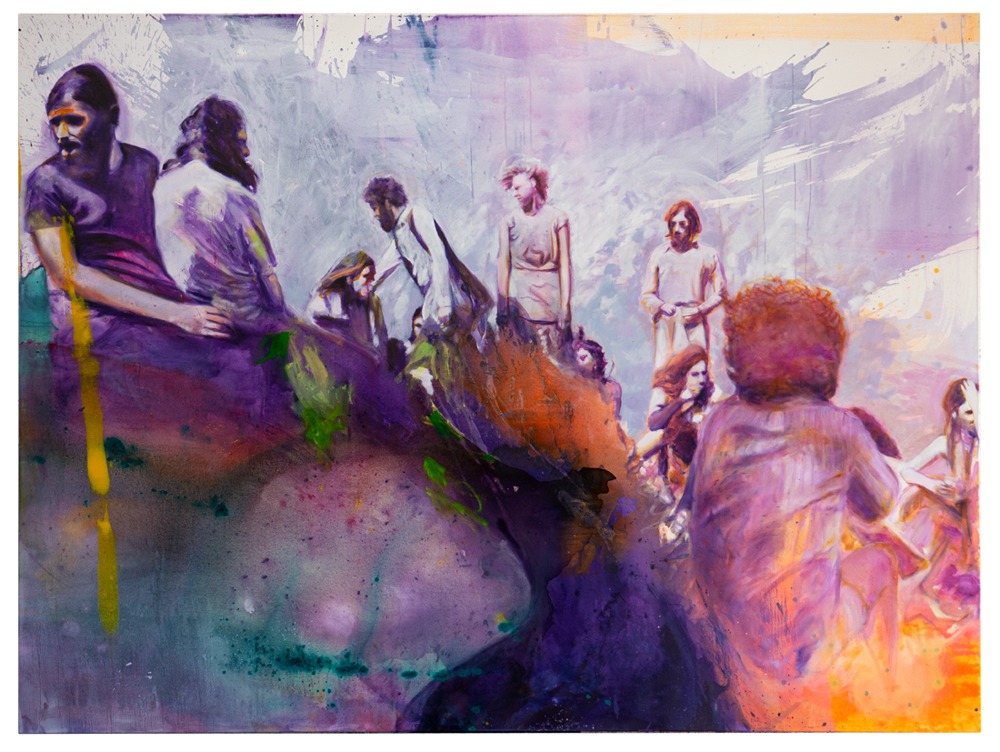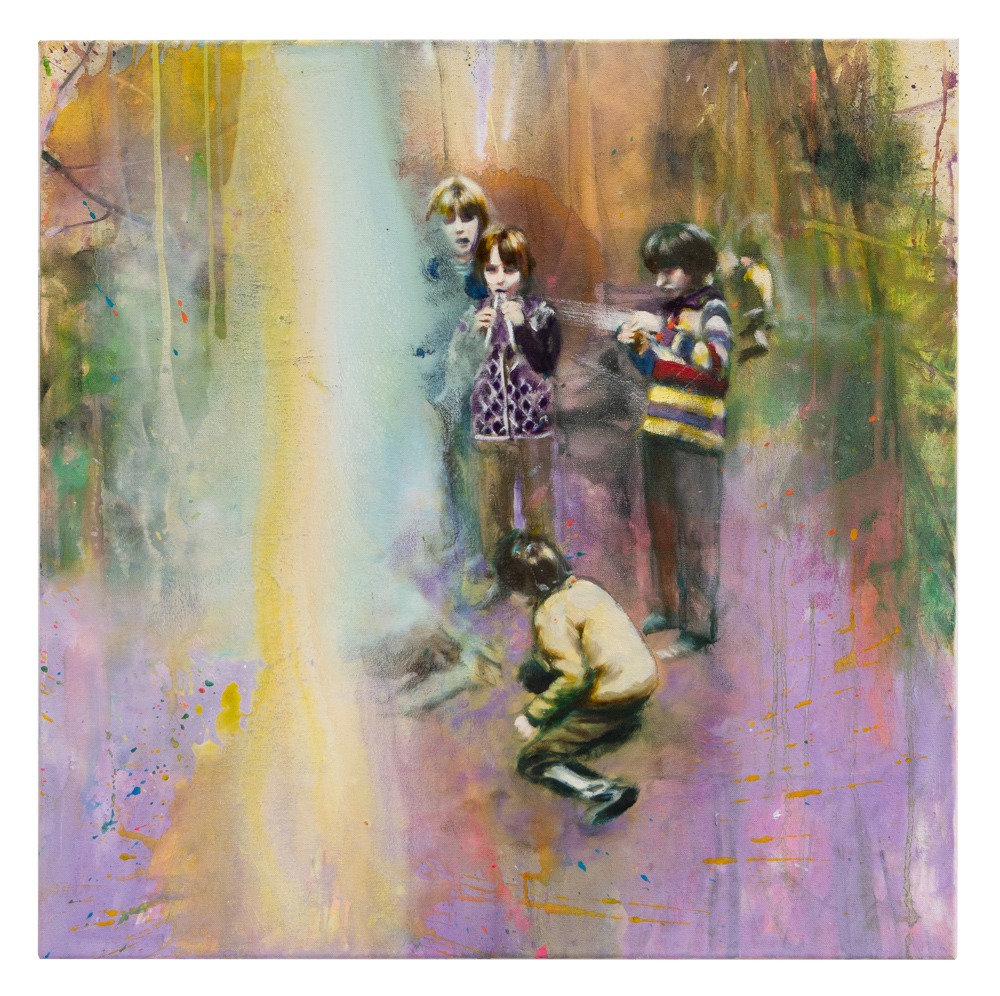Till Gerhard - We're all like Mirrors
11 - 26 Sep 2020
Galerie Michael Janssen is pleased to present “We’re all like Mirrors,” a solo exhibition by Till Gerhard. Consisting of a series of recent paintings, all produced within the last year, the exhibition will be the artist’s fourth solo showing at the gallery that will take place during gallery weekend and will be the last exhibition before the gallery relocates to its new space in Berlin.
In the exhibition, Gerhard presents paintings in the style now characteristic of his oeuvre that combines pop, quintessential images with dream scenes of figures awash in nature. These oil and acrylic paintings blur media representations with fantasy worlds, worlds that do not so much depart from the real but are remembered pasts, significant recollections whose edges have begun to speckle under time’s duress. Such is the case with the work Pied Piper, a painting named after the folk tale of the same name. Gerhard has depicted four children transfixed. They are fixed on a point, a horizon perhaps, that lies in front of them – a place in the canvas that was brushed away. What we can read instead is the children’s expressions of awe, reminding the viewer that childhood is always folded into another reality, one which doesn’t have clear navigable coordinates, but must be decoded and thus, altered. Resonating this style, another painting titled Filz shows a figure in mid stride, walking away from a green forest made of wide brushstrokes of dark green and magenta. In the place of a face, there is just ghostly sinews.
Many of Gerhard’s paintings have a distinct rhythm. This rhythm is often generated from a scene being disrupted. Though many of the images draw on iconographic imagery, such as a photograph of Bob Dylan in Bob, a portrait of the musician or a scene from a festival in the show’s eponymous painting We’re all Like Mirrors. Seen through the artist’s lens, these scenes become incongruous, partially remembered and partially imagined. This effect is created through an almost monochrome wash of purple, out of which figures emerge. The figures are frozen, enmeshed in a psychedelic cadence, while other parts of the canvas are abstracted grounds of colors.
Though many of the works within the series that make up “We’re all like Mirrors” are painted after iconic scenes that are part of collective memory, Gerhard’s fragmented abstractions expands on how collective memory often discards and selects imperfectly. As in the song “Anthem” by Leonard Cohen that was inspirational for this series of works: “There is a crack in everything, that’s how the light gets in.” This crack is made evident in the speckled flecks of color in Pyro, a painting where three men stand in front of an orange plane. Grayish spots of paint interrupt the image, pulling the viewer away from the scene. Like on a photographic negative that is sometimes seized by a chemical reaction that degrades the pictorial plane, the work reminds us that every image can give way to entropy. The matter of these entropic elements, as time to experience, both forebode destruction and hold the power to make the image anew. These two states, oblivion and recollection sit together on the surface within this series. Is forgetting memory’s undoing, or are images still images when robbed of their power to accurately portray? Rather, the two in the right balance, can materialize new possibilities and interplays.
Text: Vanessa Gravenor
In the exhibition, Gerhard presents paintings in the style now characteristic of his oeuvre that combines pop, quintessential images with dream scenes of figures awash in nature. These oil and acrylic paintings blur media representations with fantasy worlds, worlds that do not so much depart from the real but are remembered pasts, significant recollections whose edges have begun to speckle under time’s duress. Such is the case with the work Pied Piper, a painting named after the folk tale of the same name. Gerhard has depicted four children transfixed. They are fixed on a point, a horizon perhaps, that lies in front of them – a place in the canvas that was brushed away. What we can read instead is the children’s expressions of awe, reminding the viewer that childhood is always folded into another reality, one which doesn’t have clear navigable coordinates, but must be decoded and thus, altered. Resonating this style, another painting titled Filz shows a figure in mid stride, walking away from a green forest made of wide brushstrokes of dark green and magenta. In the place of a face, there is just ghostly sinews.
Many of Gerhard’s paintings have a distinct rhythm. This rhythm is often generated from a scene being disrupted. Though many of the images draw on iconographic imagery, such as a photograph of Bob Dylan in Bob, a portrait of the musician or a scene from a festival in the show’s eponymous painting We’re all Like Mirrors. Seen through the artist’s lens, these scenes become incongruous, partially remembered and partially imagined. This effect is created through an almost monochrome wash of purple, out of which figures emerge. The figures are frozen, enmeshed in a psychedelic cadence, while other parts of the canvas are abstracted grounds of colors.
Though many of the works within the series that make up “We’re all like Mirrors” are painted after iconic scenes that are part of collective memory, Gerhard’s fragmented abstractions expands on how collective memory often discards and selects imperfectly. As in the song “Anthem” by Leonard Cohen that was inspirational for this series of works: “There is a crack in everything, that’s how the light gets in.” This crack is made evident in the speckled flecks of color in Pyro, a painting where three men stand in front of an orange plane. Grayish spots of paint interrupt the image, pulling the viewer away from the scene. Like on a photographic negative that is sometimes seized by a chemical reaction that degrades the pictorial plane, the work reminds us that every image can give way to entropy. The matter of these entropic elements, as time to experience, both forebode destruction and hold the power to make the image anew. These two states, oblivion and recollection sit together on the surface within this series. Is forgetting memory’s undoing, or are images still images when robbed of their power to accurately portray? Rather, the two in the right balance, can materialize new possibilities and interplays.
Text: Vanessa Gravenor



